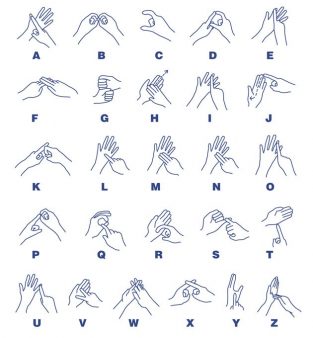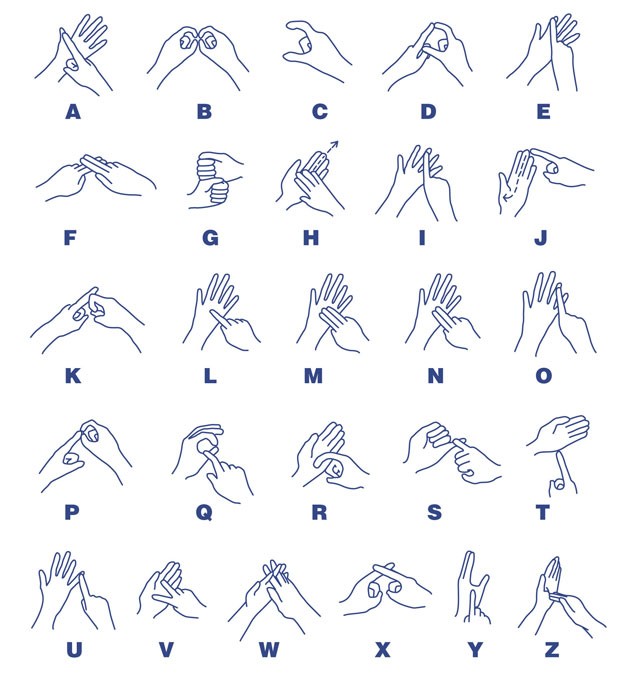Level 1 British Sign Language run by Cardiff University
23 May 2014
“Do you want to learn sign language?” is where this all started, around this time last year. One of my friends suggested that we see if there were any spaces on the (usually oversubscribed) Level 1 British Sign Language course, run by the Skills and Development Service (a part of our University that runs loads of personal development courses to help you out with your employability and self development). There are only about 20 places on the course each year and luckily we got on just in time to be offered a couple of the last few spaces!
So, what is British Sign Language? BSL is used by around 145,000 people across the UK, and is the main language of 15,000 (from the 2011 census). It is a sophisticated visual language with its own unique structure and idiosyncrasies. Of course, it is not just those who are Deaf that use BSL, a lot of people learning today are hearing; some learn to aid communication with friends or family, where others are health professionals who may need to use BSL to aid interaction with patients. Personally, I have tried teaching myself BSL quite a few times in the past so was eager to have the chance to learn from an actual teacher, not to mention that the programme is subsidised by the University so that it makes it a lot more student friendly on your wallet!
As a little bit of background, BSL qualifications are accredited by a charity called Signature and are split into 4 qualifications. Your Level 1 is an introduction into BSL, it gives you the knowledge to have a basic conversation and lays down the foundations of BSL structure and hand shapes. Level 2 is a longer course which builds on foundation knowledge, and gets you to the intermediate ish stage and then at after Level 3 you are probably an advanced BSL user. After the most common 3 there is also the Level 6 (no idea why the numbers jump so much!) which on the website describes you as using BSL ‘professionally’ with Deaf people. After this you could go on to become a translator/interpreter and essentially be fluent 🙂
Our classes began in the first week back in October and carried on until March, 2 hours every Wednesday and Thursday night – looking back none of us have a clue how we managed to fit it all in! We ended up with a really great group of people and all of us loved working together – learning BSL is very much a teamwork affair. Practising with each other is essential to moving more fluidly and helps when you forget a sign! We took 3 exams as part of our Level 1, each progressively harder and you need to pass all 3 to be awarded your Level 1 certificate.
The exams are a conversation with your teacher around a certain topic, which included food and drink, family, giving directions, pets and a few others! They are filmed and then sent off to be assessed by Signature, and we then get our marks from John at SDS 🙂
We all had such a great year, and to be honest it was a much more productive use of my Wednesday and Thursday nights than watching iPlayer so all in all a good decision! It’s a really fun thing to do and a great qualification to have.
Last night those of us who could make it made our way back to our usual room for one final farewell and to receive our certificate in a small award ceremony which was really fun! It really hit home when Bob revealed that Level 1 should have a recommended 64 hours of teaching time and our course allowed for around 36, and we still all passed! Not to mention juggling a degree and other commitments on the side! We are all really proud of ourselves and quite a few of us are hoping to get the chance to continue in the future!
Since this week is Deaf Awareness Week (happy coincidence!) I thought I’d leave you all with a few tips for communicating with Deaf people who you may meet or work with. 🙂
- Get someone’s attention by tapping them lightly on the shoulder if necessary. No need to whack someone, but if they cannot hear you then shouting isn’t going to help.
- Do not speak super slowly. Deaf people will often lip-read, and it can throw people off if you are over pronouncing words at a pace that is not normal! Just talk clearly and keep your hands away from your mouth!
- If you are with someone you know is Deaf or hard of hearing then make an effort to include them in any group conversations. If they are relying on lip-reading then a busy group conversation can be hard to follow – let them know what’s going down, feeling left out is rubbish!
- Do not give up when communicating. If talking isn’t working, why not trying writing your message down, and don’t be afraid to use visual cues.
- Why not try learning the BSL alphabet? 😀 I’ve included it below just in case, you never know when it might come in useful!

Thanks for reading guys, hope this has been a useful insight to my experiences with BSL so far 🙂 If you have any questions feel free to leave them in the comments! In other news, 3 exams down and 2 to go – not much longer to struggle in the library but a little look into revision land at Cardiff is coming soon!
Nina 🙂
Comments
1 comment
Comments are closed.
Level 1 British Sign Language run by Cardiff University
23 May 2014
“Do you want to learn sign language?” is where this all started, around this time last year. One of my friends suggested that we see if there were any spaces on the (usually oversubscribed) Level 1 British Sign Language course, run by the Skills and Development Service (a part of our University that runs loads of personal development courses to help you out with your employability and self development). There are only about 20 places on the course each year and luckily we got on just in time to be offered a couple of the last few spaces!
So, what is British Sign Language? BSL is used by around 145,000 people across the UK, and is the main language of 15,000 (from the 2011 census). It is a sophisticated visual language with its own unique structure and idiosyncrasies. Of course, it is not just those who are Deaf that use BSL, a lot of people learning today are hearing; some learn to aid communication with friends or family, where others are health professionals who may need to use BSL to aid interaction with patients. Personally, I have tried teaching myself BSL quite a few times in the past so was eager to have the chance to learn from an actual teacher, not to mention that the programme is subsidised by the University so that it makes it a lot more student friendly on your wallet!
As a little bit of background, BSL qualifications are accredited by a charity called Signature and are split into 4 qualifications. Your Level 1 is an introduction into BSL, it gives you the knowledge to have a basic conversation and lays down the foundations of BSL structure and hand shapes. Level 2 is a longer course which builds on foundation knowledge, and gets you to the intermediate ish stage and then at after Level 3 you are probably an advanced BSL user. After the most common 3 there is also the Level 6 (no idea why the numbers jump so much!) which on the website describes you as using BSL ‘professionally’ with Deaf people. After this you could go on to become a translator/interpreter and essentially be fluent 🙂
Our classes began in the first week back in October and carried on until March, 2 hours every Wednesday and Thursday night – looking back none of us have a clue how we managed to fit it all in! We ended up with a really great group of people and all of us loved working together – learning BSL is very much a teamwork affair. Practising with each other is essential to moving more fluidly and helps when you forget a sign! We took 3 exams as part of our Level 1, each progressively harder and you need to pass all 3 to be awarded your Level 1 certificate.
The exams are a conversation with your teacher around a certain topic, which included food and drink, family, giving directions, pets and a few others! They are filmed and then sent off to be assessed by Signature, and we then get our marks from John at SDS 🙂
We all had such a great year, and to be honest it was a much more productive use of my Wednesday and Thursday nights than watching iPlayer so all in all a good decision! It’s a really fun thing to do and a great qualification to have.
Last night those of us who could make it made our way back to our usual room for one final farewell and to receive our certificate in a small award ceremony which was really fun! It really hit home when Bob revealed that Level 1 should have a recommended 64 hours of teaching time and our course allowed for around 36, and we still all passed! Not to mention juggling a degree and other commitments on the side! We are all really proud of ourselves and quite a few of us are hoping to get the chance to continue in the future!
Since this week is Deaf Awareness Week (happy coincidence!) I thought I’d leave you all with a few tips for communicating with Deaf people who you may meet or work with. 🙂
- Get someone’s attention by tapping them lightly on the shoulder if necessary. No need to whack someone, but if they cannot hear you then shouting isn’t going to help.
- Do not speak super slowly. Deaf people will often lip-read, and it can throw people off if you are over pronouncing words at a pace that is not normal! Just talk clearly and keep your hands away from your mouth!
- If you are with someone you know is Deaf or hard of hearing then make an effort to include them in any group conversations. If they are relying on lip-reading then a busy group conversation can be hard to follow – let them know what’s going down, feeling left out is rubbish!
- Do not give up when communicating. If talking isn’t working, why not trying writing your message down, and don’t be afraid to use visual cues.
- Why not try learning the BSL alphabet? 😀 I’ve included it below just in case, you never know when it might come in useful!

Thanks for reading guys, hope this has been a useful insight to my experiences with BSL so far 🙂 If you have any questions feel free to leave them in the comments! In other news, 3 exams down and 2 to go – not much longer to struggle in the library but a little look into revision land at Cardiff is coming soon!
Nina 🙂

hi i am an OT student in the heath, have a deaf family member so have always been interested in learning sign language and feel it would help in my future career. is the course still available and if so, where can i sign up? thank you